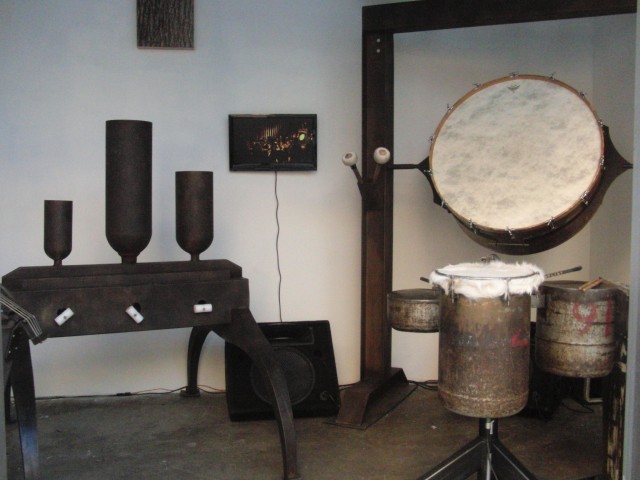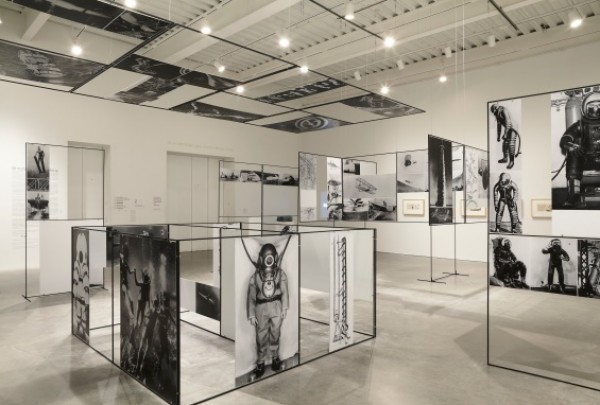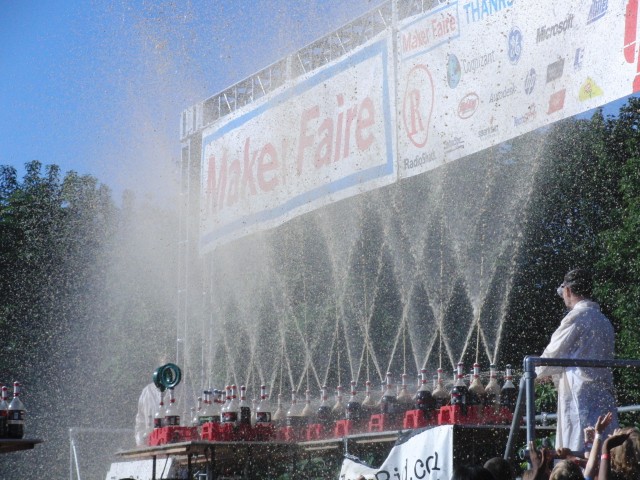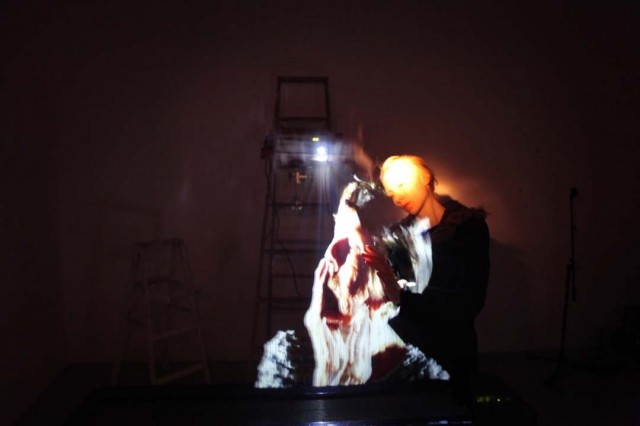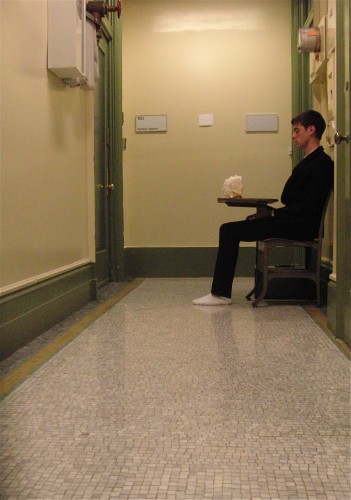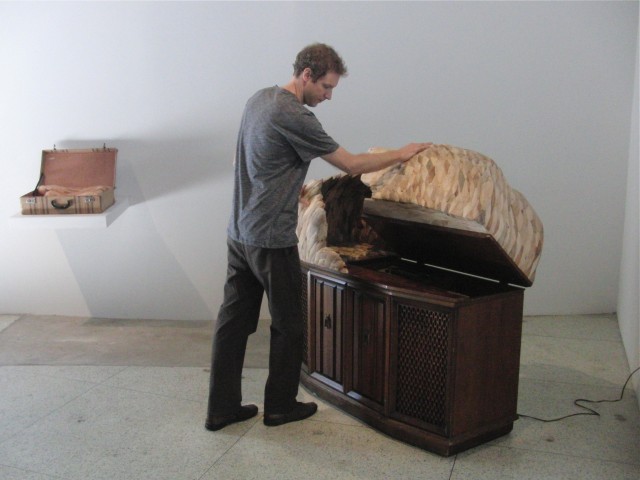
Thomas Beale prepares for a bit of delirium as innovative Honey Space gets ready for farewell to Chelsea (photo by twi-ny/mdr)
HONEY SPACE
Honey Space
148 Eleventh Ave. between 21st & 22nd Sts.
Through September 29, free, 10:00 am – 6:00 pm
www.honey-space.com
Five years ago, we were strolling rather aimlessly through Chelsea galleries when we came upon an odd sight on Eleventh Ave. In what looked like an abandoned warehouse with its metal gate up, a man’s head was popping up from under the floor, his noggin surrounded by biomorphic wooden sculptures. With the traffic passing by on the West Side Highway, we ventured in and met Dartmouth graduate Thomas Beale, an artist who was taking over the eight-hundred-square-foot space on a temporary basis for free, courtesy of real estate developer Alf Naman, who was allowing Beale to do anything he wanted with it as long as he served as a kind of maintenance man for the building. The friendly Beale talked about his plans for the gallery and discussed his work, intriguing sculptures made from found wood and shells. “Temporary” ended up being more than five years, during which Beale put on a series a fascinating shows, many with interactive performance elements, each time dramatically changing the space. He also often left the door/gate wide open, with no one minding the store, allowing people to come and go without supervision — and without incident.
Visitors were invited to enter Daphane Park’s “Superconductor” and investigate their consciousness, have a drink in Mickey Western’s “Gringolandia” and ask Western to play a song, share their secrets with a pair of scantily clad women for Inner Course’s “Panties for Diamonds,” or climb a ladder down into Jane Watson and Swoon’s haunting “Portrait of Silvia Elena,” which examined the string of rapes and murders of young girls and women that continues in Juarez, Mexico. Beale is now saying farewell to Honey Space with one final exhibit, which he is simply titling “Honey Space,” featuring his own works, including “Delirium,” an old stereo console topped with a dome of found wood, “Gift,” a hat box with found wood emerging from it like a balloon, and a field of living grass with various objects on it, most prominently the shimmering “Skyglass,” made of reclaimed temple wood and Japanese lacquer. As he prepared for Honey Space’s final days — there will be a “Feast of Friends” celebration Thursday night from 8:00 to 12 midnight with performances by Mesiko, Behavior, Mickey Western, and DJ Hahaha — Beale took a few minutes to look back on his time there and consider what comes next.
twi-ny: In your announcement of this final exhibition, you express “supreme pleasure.” Surely there’s at least a twinge of sadness at leaving, no?
Thomas Beale: Without a doubt. It’s a major transition, and my years in this building, and operating Honey Space, have been a once-in-a-lifetime experience. Nonetheless, I was originally offered a year and a half to two years in this building, which has become more than six. I always hoped to end the experience of Honey Space with an exhibition of my own work, and I was able to do that. So I leave with few regrets. . . . Really, the feeling that I was offered more than I ever dreamed of, and I did the absolute maximum with it.
twi-ny: Do you have a favorite memory or two that occurred inside Honey Space?
Thomas Beale: Mickey Western’s “Gringolandia” was an experience like none other. The closing party was the peak, not only of that exhibition, but of the arc of Honey Space itself. It was early November 2008, the economic crash had just happened, everyone was reeling and trying to figure out what the new world was going to look like, it was nineteen degrees outside, and there were two hundred people packed inside an eight-hundred-square-foot space covered in tin foil, blinking lights, a circular stage, an illegal bar . . . literally packed, shoulder to shoulder, like sardines. One of the bands playing that night, a nine-piece brass band from New Orleans, took fifteen minutes to navigate the thirty feet through the crowd from the door to the stage. When they began playing — and I swear I have never seen this happen anywhere before or since — the entire room started swaying back and forth, in one single motion. The bodies were so tight together you couldn’t avoid it, and no one was in control. For the final “silver ceremony” at midnight, we crowd-surfed the Gringolandia silver grandfather clock to the front door and back. It was epic; the energy was like none other. When the cops finally arrived at 3 am, my first words to them were “What took you so long?”
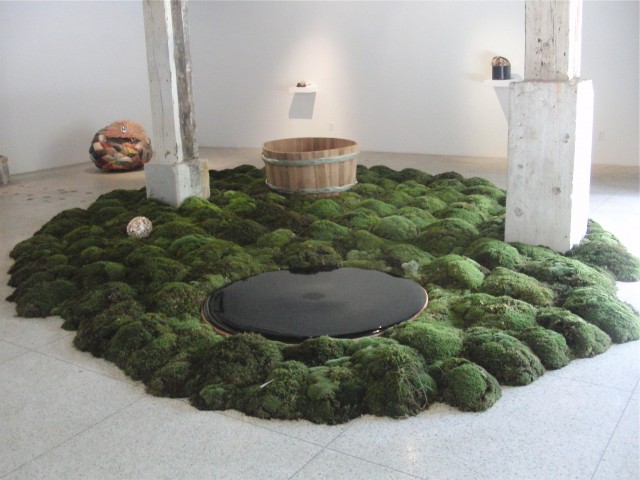
Honey Space says goodbye to Chelsea with an exhibit featuring living grass (photo by twi-ny/mdr)
twi-ny: Over the five-plus years you were here, you often transformed the space. How would you say it transformed you, both as an artist and a person?
Thomas Beale: In so many ways. After Honey Space, my life as an artist is something entirely different, and at the same time, not at all dissimilar from what it was before. Collaborating with other artists to flesh out their visions is something I’ll take a lot away from — both in my own exhibition-making and other curating I may do in the future. I learned how hungry people are for the radical gesture, how humanizing it is for so many people . . . the pleasure you can take from doing something independently . . . and that old truism that what you put out into the world will be returned back to you.
twi-ny: Is there anything you can reveal about your new space in Brooklyn? Will you attempt something similar to what went on at Honey Space, or are you planning something different?
Thomas Beale: Someone is offering me another rent-free studio for a period of time, but I only plan to use it to create my own work. Honey Space was interesting to me because it was in the middle of Chelsea, something so unlikely, that could look and feel so different from the rest of Chelsea, and the freedom I had here allowed me to do things that would resonate in contrast. I imagine that I will curate other exhibitions sometime again in the future, but for the immediate term, I’m excited to dive into my own creative practice.
twi-ny: Will there be a final blow-out for Honey Space, or will it be a quiet farewell?
Thomas Beale: Thursday, September 27, 8:00 to midnight, “A Feast of Friends.” Three bands and a DJ friend who have all been a close part of family of this space will be performing. It will not be quiet.
